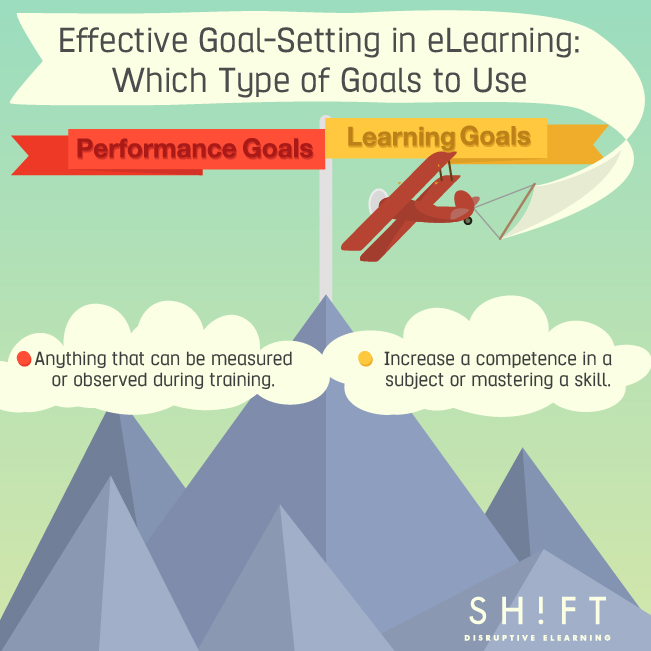The secret to eLearning success is not only setting goals, but setting the right goals. In order to achieve the required end results, understanding the difference between the different types of goals and when each is appropriate to use is very important. Clarifying goals since the beginning will impact your course content, the way it's structured and developed. Besides, if you don’t design with the right type of goals in mind, the eLearning module will be a waste of time and money, since the problem needs to be addressed from other perspectives.
When starting with Goal Setting, there are different kinds of goals based on the situation and the learning context. In this post, we will discuss the two main types of goals that you can use in eLearning.But before starting reading, it's very important you understand the difference between goals and objectives. This article clearly differentiate both terms.

Performance Goals
What Are Performance Goals?
Performance relates to anything that can be measured or observed during training; therefore, performance goals tend to be based around standards and function to demonstrate a person’s ability or skill to others. VandeWalle defines performance goal orientation as the "desire to prove one's competence and to gain favorable judgments about it". Learner’s achievements are often determined through an exam result or their productivity in the work environment. Basically, the ultimate objective in courses that include performance goals is for the learner to be able to do something after its completion.
When To Use Them
For short term purposes, performance goals can be highly beneficial, especially when used in the right situations, such as when the employee already has a good understanding of how to complete the tasks. Well-designed eLearning courses with performance goals provide plenty of opportunity for practice; for instance, they enable learners to review and identify weaknesses and to practice behaviors that address these weaknesses.
How to Use Them
Performance goals are consequence goals, meaning they encompass a specific desired outcome that is gained by performing a task. Effective goal-setting for performance goals means starting each goal with an action verb that describes the activity and sharing these goals at the start of the eLearning course.
eLearning developers can ensure that learners meet performance goals by providing them with all necessary information and support. To avoid mechanical answers, creators should incorporate activities that involve interaction with peers, experts, and trainers. Finally, the link between performance and compensation should be obvious; for instance, by rewarding top performers and providing regular feedback.
Extra Tip: Here is a handy list of action verbs you can use to develop performance goals.
Learning Goals
What Are Learning Goals?
In the words of VandeWalle, learning goal orientation is defined as the "desire to develop the self by acquiring new skills, mastering new situations and improving one's competence". eLearning courses with learning goals focus on the active process of gaining information, increasing one’s understanding, and improving capabilities. For trainers, this means placing less emphasis on producing results and more on ensuring learners understand fundamentals.
When To Use Them
Learning goals are best for situations where employees are learning a completely new skill or are trying to improve a current skill and have no strategy for related accomplishing goals. Learning goals are particularly useful during training mandated by an organization that has no real performance goals such as training programs designed to build awareness and common knowledge.
How to Use Them
Learning goals are typically written in a form like “At the end of this course, you will be able to…” This format enables students to gauge the difficulty of completing the course, even if they are yet to master the terminology of the subject. Effective goal-setting involves omitting vague terms such as “Know” and focusing on how a student can demonstrate the necessary level of understanding.
The Two Compared
Both performance and learning goals are commonly used, are beneficial to the learner, and provide an incentive for achievement. In eLearning, performance goals typically receive more attention because they enable managers to work with employees to develop goals centered on workplace accomplishments. Learning goals, on the other hand, are based on an employee’s desire to improve skills and abilities for a higher level of productivity in the workplace, but when effective goal-setting methods are in place, they can lead to long term benefits for both the employee and employer.
Remember: "Learning is easier when learners understand what goal they are trying to achieve, the purpose of achieving the goal, and the specific attributes of success". Chappuis & Stiggins, 2002
Further Reads:
- Identifying Pedagogical Goals, Objectives & Outcomes
- Managing E-learning: Design, Delivery, Implementation, and Evaluation




